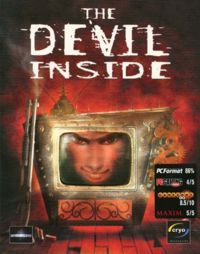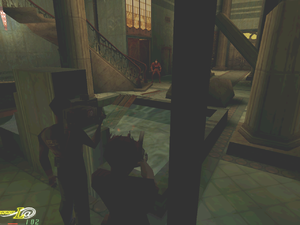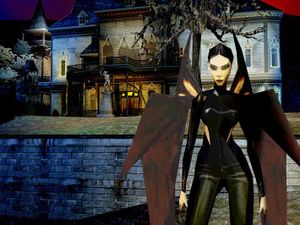On November 27th, 2022, the 8,000th article was added to the SuccuWiki!
The Devil Inside: Difference between revisions
(New page: Category:Film and Media ''For other uses of the word Succubus, see Succubus (disambiguation).'' [[Image:Devilinsideus.jpg|thumb|right|US Box cover for the video game The D...) |
mNo edit summary |
||
| Line 1: | Line 1: | ||
[[Category:Film and Media]] | [[Category:Film and Media]] | ||
{{Infobox video game | |||
|title = The Devil Inside | |||
|image = [[File:Devilinsideus.jpg|256px|US Box cover for The Devil Inside]] | |||
|caption = North American box cover | |||
|developer = Gamesquad | |||
|publisher = Cryo Interactive | |||
|distributor = {{vgrelease|NA=Take-Two Interactive}} | |||
|released = {{vgrelease|EU=March 2000|NA=October 2000}} | |||
|genre = Third-person shooter <br> Survival horror | |||
|modes = Single-player | |||
|ratings = ESRB: M<br />USK: 16+ | |||
|platforms = Microsoft Windows | |||
}} | |||
''For other uses of the word [[Succubus]], see [[Succubus (disambiguation)]].'' | ''For other uses of the word [[Succubus]], see [[Succubus (disambiguation)]].'' | ||
[[Image:Devilinsideuk.jpg|thumb|right|200px|United Kingdom Box cover for The Devil Inside]] | |||
[[Image: | '''The Devil Inside''' is a horror-themed third-person shooter video game released in 2000 by Cryo Interactive. The game's script was written by Hubert Chardot, better known for his work in the ''Alone in the Dark'' series.<ref name="gamespot">{{cite web |url=http://www.gamespot.com/pc/adventure/devilinside/review.html?om_act=convert&om_clk=gssummary&tag=summary;review |title=The Devil Inside for PC review |accessdate=2008-06-17 |author=Greg Kasavin |date=2000-11-17 |publisher=GameSpot}}</ref> The game is presented as a reality television game show documenting the supernatural exploits of the protagonist Dave and his titular alter ego, a [[Succubus (Traditional)|succubus]] named Deva. The game's theme was frequently compared to ''The Running Man'',<ref>[http://www.justadventure.com/reviews/Devil_Inside/Devil_Inside.shtm Review: The Devil Inside]</ref><ref>{{cite news| url=http://www.guardian.co.uk/technology/2000/may/25/onlinesupplement5 | work=The Guardian | location=London | title=Games reviews | first=Greg | last=Howson | date=2000-05-25 | accessdate=2010-05-25}}</ref> written by Stephen King, whose name is mentioned early in the game. | ||
| Line 24: | Line 31: | ||
*Platforms: Microsoft Windows | *Platforms: Microsoft Windows | ||
*Media: CD | *Media: CD | ||
==Gameplay== | ==Gameplay== | ||
[[ | [[File:Devilingame.png|thumb|right|Dave takes aim at a shotgun-wielding Electrocuted Criminal.]] | ||
The player can transform between Dave and Deva by activating pentagrams located at certain places throughout the game's levels. During gameplay, Dave/Deva is followed by a small flying camera as well as a cameraman, and the player can switch between the two camera views as desired. Occasionally, a news helicopter will also be present and scripted cutscenes will be viewed from an aerial perspective. | The player can transform between Dave and Deva by activating pentagrams located at certain places throughout the game's levels. During gameplay, Dave/Deva is followed by a small flying camera as well as a cameraman, and the player can switch between the two camera views as desired. Occasionally, a news helicopter will also be present and scripted cutscenes will be viewed from an aerial perspective. | ||
[[Image:deva.jpg|thumb| | |||
[[Image:deva.jpg|thumb|right|The Succubus Deva]] | |||
The pacing, exploration, and puzzle factor of the game is similar to that of other survival horror titles. As Dave, the player has access to a variety of guns, which are equipped with laser sights to assist the player in aiming. As Deva, the player uses spells to attack enemies. Spells do not require ammunition, but do deplete mana that regenerates slowly. Some enemies generate souls when killed, and Deva can inhale souls to replenish her mana. Deva also has the ability to fly and regenerate health when standing in fire. | The pacing, exploration, and puzzle factor of the game is similar to that of other survival horror titles. As Dave, the player has access to a variety of guns, which are equipped with laser sights to assist the player in aiming. As Deva, the player uses spells to attack enemies. Spells do not require ammunition, but do deplete mana that regenerates slowly. Some enemies generate souls when killed, and Deva can inhale souls to replenish her mana. Deva also has the ability to fly and regenerate health when standing in fire. | ||
The game uses a checkpoint save system represented by television sets found in-game. | The game uses a checkpoint save system represented by television sets found in-game. | ||
==Reception== | ==Reception== | ||
GameSpot awarded the game a 6.8 out of 10, citing difficulties with the control scheme. In regards to the game's action sequences, the reviewer stated that "Some of the battles are scripted very well. [...] But other times, the combat is poor." The environments of the game were praised for their realism and atmosphere, while character models and sound effects were rated as plain. Overall, the game was described as competent but lacking polish.<ref> | GameSpot awarded the game a 6.8 out of 10, citing difficulties with the control scheme. In regards to the game's action sequences, the reviewer stated that "Some of the battles are scripted very well. [...] But other times, the combat is poor." The environments of the game were praised for their realism and atmosphere, while character models and sound effects were rated as plain. Overall, the game was described as competent but lacking polish.<ref name="gamespot"/> | ||
''PC Gamer US'' gave the game a score of 79% in their January 2001 issue. The review praised the animations, camera angles, the use of a dual character, and the game's low learning curve. However, the review cited "poor polygonal figures and texturing", and some environmental bugs as the low points of the game. | |||
==Controversy== | |||
In Poland, it was one of the first of the series of cheap premiere releases in ''ExtraGra'' magazine. Shortly after the game's release, one of Poland's most popular TV stations, TVN aired a report on the game, accusing the distributor, CD Projekt of selling satanic games in commonly accessible kiosks. The Epilepsy warning, which by the time was already common among video games released in Poland and almost omnipresent in Europe, was used as an example of the game's exceptionally negative impact on young people. | |||
==References== | ==References== | ||
{{reflist}} | {{reflist}} | ||
*[http://www.mobygames.com/game/windows/devil-inside Mobygames | ==External Links== | ||
*[http://en.wikipedia.org/wiki/The_Devil_Inside_%28video_game%29 The original source of this article at Wikipedia] | |||
*[http://www.mobygames.com/game/windows/devil-inside The Devil Inside at Mobygames] | |||
*[http://www.imdb.com/title/tt0284036/ The Devil Inside at the Internet Movie Database] | *[http://www.imdb.com/title/tt0284036/ The Devil Inside at the Internet Movie Database] | ||
Latest revision as of 12:41, 14 August 2014
For other uses of the word Succubus, see Succubus (disambiguation).
The Devil Inside is a horror-themed third-person shooter video game released in 2000 by Cryo Interactive. The game's script was written by Hubert Chardot, better known for his work in the Alone in the Dark series.[1] The game is presented as a reality television game show documenting the supernatural exploits of the protagonist Dave and his titular alter ego, a succubus named Deva. The game's theme was frequently compared to The Running Man,[2][3] written by Stephen King, whose name is mentioned early in the game.
Game Information
- Title: The Devil Inside
- Developer: Gamesquad
- Publisher: Cryo Interactive
- Distributor: Take-Two Interactive (US)
- Released: Europe: March 2000, North America: October 2000
- Genre: Third-person shooter, Survival horror
- Modes: Single-player
- Ratings: ESRB: Mature, USK: 16+
- Platforms: Microsoft Windows
- Media: CD
Gameplay
The player can transform between Dave and Deva by activating pentagrams located at certain places throughout the game's levels. During gameplay, Dave/Deva is followed by a small flying camera as well as a cameraman, and the player can switch between the two camera views as desired. Occasionally, a news helicopter will also be present and scripted cutscenes will be viewed from an aerial perspective.
The pacing, exploration, and puzzle factor of the game is similar to that of other survival horror titles. As Dave, the player has access to a variety of guns, which are equipped with laser sights to assist the player in aiming. As Deva, the player uses spells to attack enemies. Spells do not require ammunition, but do deplete mana that regenerates slowly. Some enemies generate souls when killed, and Deva can inhale souls to replenish her mana. Deva also has the ability to fly and regenerate health when standing in fire.
The game uses a checkpoint save system represented by television sets found in-game.
Reception
GameSpot awarded the game a 6.8 out of 10, citing difficulties with the control scheme. In regards to the game's action sequences, the reviewer stated that "Some of the battles are scripted very well. [...] But other times, the combat is poor." The environments of the game were praised for their realism and atmosphere, while character models and sound effects were rated as plain. Overall, the game was described as competent but lacking polish.[1]
PC Gamer US gave the game a score of 79% in their January 2001 issue. The review praised the animations, camera angles, the use of a dual character, and the game's low learning curve. However, the review cited "poor polygonal figures and texturing", and some environmental bugs as the low points of the game.
Controversy
In Poland, it was one of the first of the series of cheap premiere releases in ExtraGra magazine. Shortly after the game's release, one of Poland's most popular TV stations, TVN aired a report on the game, accusing the distributor, CD Projekt of selling satanic games in commonly accessible kiosks. The Epilepsy warning, which by the time was already common among video games released in Poland and almost omnipresent in Europe, was used as an example of the game's exceptionally negative impact on young people.
References
- ↑ 1.0 1.1 Greg Kasavin (2000-11-17). "The Devil Inside for PC review". GameSpot. http://www.gamespot.com/pc/adventure/devilinside/review.html?om_act=convert&om_clk=gssummary&tag=summary;review. Retrieved 2008-06-17.
- ↑ Review: The Devil Inside
- ↑ Howson, Greg (2000-05-25). "Games reviews". The Guardian (London). http://www.guardian.co.uk/technology/2000/may/25/onlinesupplement5. Retrieved 2010-05-25.



